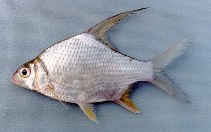| Family: |
Cyprinidae (Minnows or carps), subfamily: Cyprininae |
| Max. size: |
40 cm (male/unsexed) |
| Environment: |
benthopelagic; freshwater, potamodromous |
| Distribution: |
Asia: Mekong basin. |
| Diagnosis: |
Last simple anal ray osseus and serrated posteriorly; pale orange anal, pelvic and dorsal fins; last simple dorsal ray reaching the caudal fin in adults and with 28-36 serrae (in specimens 6-15 cm SL) (Ref. 27732); serrated anal spine; silvery body coloration (Ref. 12693). |
| Biology: |
Inhabits large upland rivers. Seems to avoid standing water. Little is known about its biology. Like other members of the genus, it probably feeds mainly on plant matter and occasionally on insects and insect larvae (Ref. 12693). Also reported to prefer deep pools in the river and to migrate into streams, canals and lakes during the flood season. Migrates in large schools (Ref. 37770). Migrates together with Cosmochilus harmandi, Cirrhinus spp., Labeo chrysophekadion and Bangana sp (Ref. 37770). Marketed fresh (Ref. 12693). |
| IUCN Red List Status: |
Least Concern (LC); Date assessed: 20 February 2011 Ref. (130435)
|
| Threat to humans: |
harmless |
Source and more info: www.fishbase.org. For personal, classroom, and other internal use only. Not for publication.

